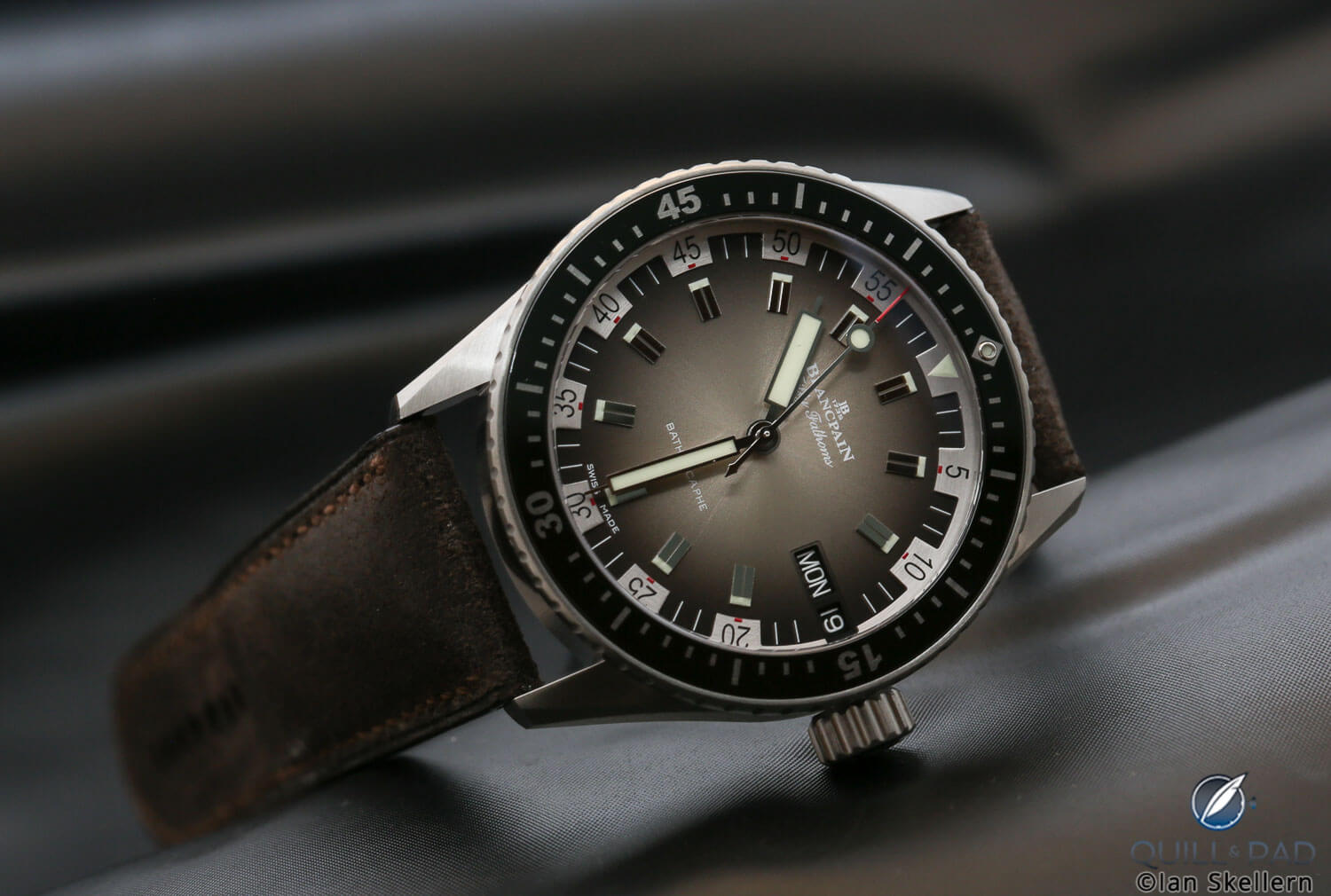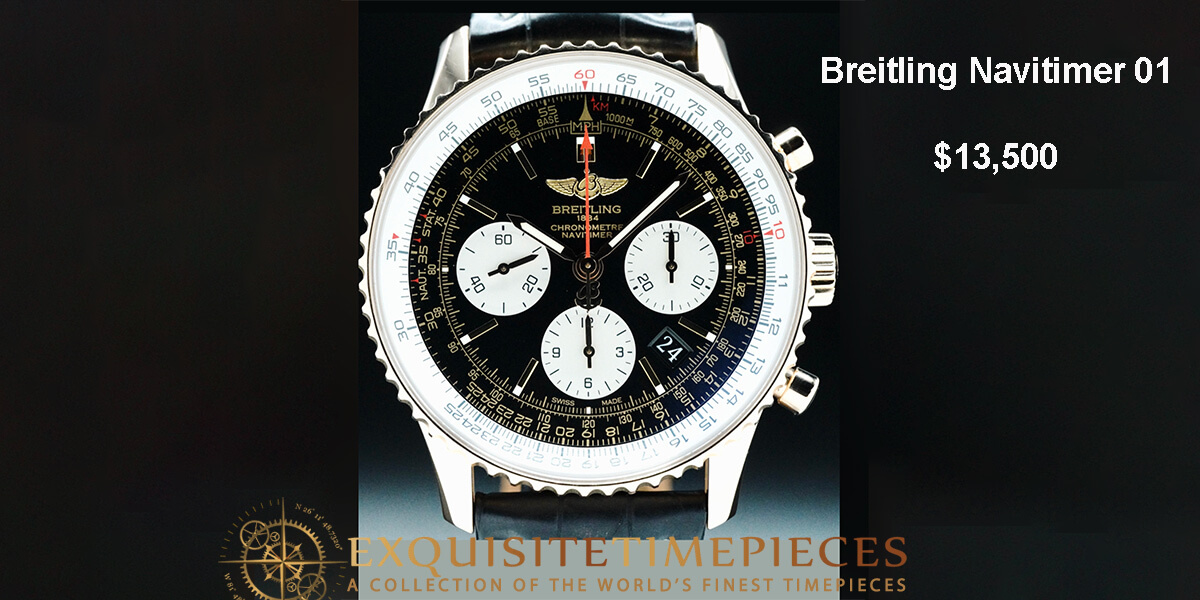The Re-Edition/Reissue Issue: Living in the Shadow of the Original
The reissue concept is relatively simple: classically correct on the outside and up to date on the inside, thereby quenching the owner’s thirst for nostalgia while sparing them maintenance issues and the associated costs, uncertainty regarding authenticity, and fragility fright.

Breitling 806 1959 Re-Edition
You wouldn’t daily, say, a ‘50s Navitimer for the same reason you wouldn’t belly-rub a mummified cat – that’s how you turn it into dust. You can, however, belly-rub Breitling’s 806 1959 Re-Edition, which (from the outside at least) is as-near-as-makes-no-difference a carbon copy of the original, all day long, causing little to no harm. And therein lies the appeal: best of both worlds, old and new.
Naturally, there’s a market for this kind of thing, extending beyond watch circles. If, for example, you are into classic cars but not into leaky, low-performing deathtraps that are constantly teetering on the edge of catastrophic failure, you can (for a million dollars) buy a new Eagle Speedster or a Tuthill 911k.

Riva Anniversario
Similarly, if you like old motorcycles, you can get yourself a new Royal Enfield Classic 350 (which is Indian) or a Kiwi Indian (which isn’t). Sadly, all 18 Riva Anniversarios are spoken for, so you’re shit out of luck in the boat department.
————————————————————————————————————–
—————————————————————————————————–
Nonetheless, guitarists have the American Vintage ’62 Stratocaster, shutterbugs have the Leica M6, and fashionistas have the Prada 2005 Re-nylon Bag. All these are, more or less, reissues. AKA: re-editions.
The term Edition gets thrown around a lot in retail. It has been (for I don’t know how long) enjoying overwhelmingly positive connotations, alluding to exclusivity and rarity, often following flashy prefixes such as Special or Limited or Re.
Dressed down, however, “Re-Edition” is just another way of saying “Re-Issue,” which is just another way of saying “Re-Production,” which is no good since it’s the antithesis of “Original,” which is what we like.

Blancpain Fifty Fathoms Bathyscaphe Day Date 70s from 2018
We like a watch from the ‘70s for the story behind it and for looks that reflect the era. A 2024 release that only looks like it’s from the ‘70s has no story worth telling. Nor does it represent the times. ‘Tis not but a sterile clone, neither here nor there, dwelling in the uncanny valley of the watch world, constantly reminding you of what it’s not: the real thing.
Seeing one in the wild bumps me. “Something’s off here,” I catch myself thinking, “but I can’t quite put my finger on it.” Not on the spot, I can’t, but I’m here now and we do have another page to fill, so here goes nothing.
A reissue, I gather, is primarily worn in hopes of duping folk into thinking it’s new-old-stock. But the watch doth sparkle too much, methinks, each facet perfectly aligning with the next, wrapped around a dial coated in paint so fresh you could smell it, black levels agape.
—————————————————————————————————–
—————————————————————————————————–
A reissue is too picture-perfect, too clean-cut. It ought to look like it fell out of an old, dusty catalog; like a quaint, imperfect gem, winking at you from across the room. Only it doesn’t. It comes on too strong, like a vivid, computer-generated image that was shaken out of an iPad.

Rolex GMT 6542 with “tropical dial” (photo courtesy www.richpatina.tumblr.com)
Enter fauxtina: a countermeasure intending to tone things down and, in turn, sell the illusion. Adding one distressed element to a watch that’s otherwise fresh out of the box, however, only exacerbates the jarring mismatch between design and condition. Perhaps a tune-up is in order. Knocking it around may not be the worst idea of all time. Neither is a flashback.

Tudor Heritage Black Bay Bronze
Remember the Bronzo craze? Deranged Panboys slathered their watches in corrosive mixtures of salt, vinegar, and (among other things) ammonia, deliberately tarnishing them to Davy-Jones-Locker levels. If wearing something that looks like it was fished out of a shipwreck appeals to you, that’s what it takes.
No “testing the waters,” no “one foot in, one foot out.” Total commitment! I encourage such behavior; it’s entertaining, albeit in a callus, watch-the-world-burn kind of way. Still, if the industry is bent on resurrecting discontinued icons, it should take a page from the Paneristi handbook – fauxtina alone won’t do it.
Neither will salt, vinegar, and ammonia. The bronze age came and went. Twice.
—————————————————————————————————–
—————————————————————————————————–
Fret not, captains of industry, I have ideas. Pass each new release pretending to be an old one through a Swiss cow before shipping it to its allocated authorized dealer – nothing says “gritty” like an “Aged by Hérens” stamp. Or marinate them in the Seine – they’ll probably come out glowing in the dark and, as an added bonus, eliminate the need for lume.
Or set fire to them and put the flames out with broomsticks. Or any combination of the above. It seems like a lot of work, but a “lot of work” is the expectation here. Watchmaking was never meant to be easy; it’s meant to be difficult and time-consuming.
This brings me to my biggest issue with the reissue: minimal time and effort to fruition. Tracing over prior work, line for line, is, at least as far as the design department is concerned, self-plagiarism. It’s the quick and easy way of doing things. That is to say, the less impressive way of doing them.
Aside from that, coming out with reissue after reissue is a blatant money grab, perpetrated by bottom-line execs known for shamelessly hopping on the bandwagon of the day. Somebody should tell them: Regularly reissuing past hits is a bad sign, suggesting that you’re fixated on the rearview mirror, your best years behind you.
It’s also pandering and disingenuous. You can almost call it “gauche.”
—————————————————————————————————–
—————————————————————————————————–
Be that as it may, the reissue train has been picking up quite a bit of steam lately and showing no signs of slowing down. As long as the watches it spits out gain the favor of tastemakers and generate the kind of buzz that moves units, it will continue chugging along.
Plagued by FOMO, nearly all the big MOFOs – aside from Patek and Rolex – jumped on it. And, boy, did it pay off.

Seamaster 300 41mm
To say that the Seamaster 300 was well-received would be an understatement. It was – and this is extraordinary for any entry-level Omega – waitlisted at one point. As was JLC’s Reverso Tribute To 1931. Ben Clymer has one. And if it’s good enough for him, it’s good enough for you. I kid. And I digress.

Jaeger-LeCoultre Tribute to Reverso 1931
Now, where was I? Ah, yes! Very well received indeed. The aforementioned Breitling 806 was a home run. Zenith gets a standing ovation for every Defy Revival model it churns out. 
Vacheron Constantin Historiques 222 then (left) and nowAnd, thanks to its looks, which are as gorgeous as they are timeless, Vacheron Constantin’s 222 stole the show when it came out a couple of years ago. All these were hits. And that begs the question…
If today’s hits are from yesterday, how will they get on decades down the line? By then, they will have joined the rank of their idols. It being: vintage – no tree to bark up if you’re looking for robustness and reliability. Or performance, for that matter.
Unique selling points rendered null and void, all we have left are looks and collectability. Since both reissue and original look so much alike and both are now old and feeble, you may as well have the daddy. As far as collectability goes, you know in your heart of hearts that the original will always reign supreme, a cosmic gap separating it from its copycat.
It is (and forgive me for being unkind here) the difference between bagging a museum piece and picking something up from the gift shop. I know which one I’d rather have.
You might also enjoy:
Fauxtina: A Faux Vintage Faux Pas
The Case Against Watch Lume: It’s Weak Sauce and Here’s Why
Sorry Guys, Size Does Matter: You’re Gonna Need a Bigger Wrist and Other Things your Watch Retailer Won’t Tell You
Grand Seiko 1960 Re-Creations: Celebrating a Turning Point
Why I Bought It: Timex Marlin Re-Edition
Leave a Reply
Want to join the discussion?Feel free to contribute!










There are different strands of thought about reissues and as Seiko calls them re-creations.
Longines often does very good reissues using contemporary ETA movements. They will vary the size from the original and infuriatingly insert a date complication even though the historic original did not have a date complication. Longines will also add fauxtina. The best Longines reissue IMHO is the Heritage 1938 Military based on a milspec order for officer watches for the Czech Army made through Prinz, Longines Polish distributor. It is pure to the original (save the modern movement) which original was an astonishing 43mm in diameter. Omega reissues (usually in limited editions) involve upgrades to more modern co-axial movements, sometime changes in materials (stainless steel is replaced by titanium) and sometimes decorative dial upgrades. Omega basically retains the spirit and general aesthetic of the original but a definite upgrade and improvement over the original based on the Speedmaster Mark II reissue, Seamaster Bullhead chronograph reissue and the Ploprof 1200M reissue, all of which references are in my collection. Seiko follows the limited edition route, adds newer movements and date complications and focuses in more on the spirit of the original than an exact reproduction based upon the SPB37 Captain Willard are-creation (the Grey Fox which has a new brushed grey dial and fauxtina), the 1965 KSK King Seiko Re-creation and the 1959 Alpinist Re-creation on bund strap, all of which references are in my collection. The stellar Omega Museum Collection reissue program begun in 2005 is not included in this discussion but those are in a league almost of their own.
Well written. The thing about wristwatches is…they’re all essentially anachronisms, so no reason to overthink it. In one case (or two??), I actually own both an original and reproduction of the same model, wearing the repro as the daily beater.
Also, fwiw, Patek and Rolex certainly participate in this. It just doesn’t feel that way, because the same models have had unbroken links of small iterations for decades. A 5711 looks as much like the original as most other brands’ reissues do to their progenitor.
I get all the points being made but if I like a look from a particular period why not buy the newer more reliable version? Provenance and stories from history are great to push up an auction price but if that’s not as important as availability of parts for servicing and water resistance why pay more for something that gives you less? Being able to use something daily which also reduces use, increasing longevity, of the original sounds good to me.
As always it’s not an either or debate. Not owning an actual WRC car when I was 8 didn’t take away from the joy I got playing with my radio controlled version. Embrace your inner child and go play!